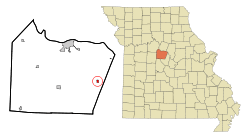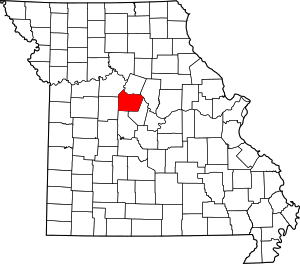Prairie Home, Missouri
Prairie Home is a town, with legal status as a city, in Cooper County, Missouri, United States. The population was 280 at the 2010 census.
Prairie Home, Missouri | |
|---|---|
 Location of Prairie Home, Missouri | |
| Coordinates: 38°48′47″N 92°35′23″W | |
| Country | United States |
| State | Missouri |
| County | Cooper |
| Area | |
| • Total | 0.39 sq mi (1.00 km2) |
| • Land | 0.39 sq mi (1.00 km2) |
| • Water | 0.00 sq mi (0.00 km2) |
| Elevation | 889 ft (271 m) |
| Population | |
| • Total | 280 |
| • Estimate (2019)[3] | 280 |
| • Density | 721.65/sq mi (278.86/km2) |
| Time zone | UTC-6 (Central (CST)) |
| • Summer (DST) | UTC-5 (CDT) |
| ZIP code | 65068 |
| Area code(s) | 660 |
| FIPS code | 29-59726[4] |
| GNIS feature ID | 0724867[5] |
History
The town of Prairie Home was laid out in 1874 around the Prairie Home Institute, a school which had been built some time earlier.[6] Prairie Home is a descriptive name, referring to its scenic setting on the prairie.[7]
Geography
Prairie Home is located at 38°48′47″N 92°35′23″W (38.813012, -92.589786),[8] along Missouri Route 87 and near its intersection with Route J. According to the United States Census Bureau, the city has a total area of 0.39 square miles (1.01 km2), all land.[9]
Demographics
| Historical population | |||
|---|---|---|---|
| Census | Pop. | %± | |
| 1880 | 43 | — | |
| 1900 | 196 | — | |
| 1910 | 184 | −6.1% | |
| 1920 | 192 | 4.3% | |
| 1930 | 151 | −21.4% | |
| 1940 | 251 | 66.2% | |
| 1950 | 208 | −17.1% | |
| 1960 | 213 | 2.4% | |
| 1970 | 231 | 8.5% | |
| 1980 | 279 | 20.8% | |
| 1990 | 215 | −22.9% | |
| 2000 | 220 | 2.3% | |
| 2010 | 280 | 27.3% | |
| Est. 2019 | 280 | [3] | 0.0% |
| U.S. Decennial Census[10] | |||
2010 census
As of the census[2] of 2010, there were 280 people, 121 households, and 85 families living in the city. The population density was 717.9 inhabitants per square mile (277.2/km2). There were 132 housing units at an average density of 338.5 per square mile (130.7/km2). The racial makeup of the city was 98.9% White, 0.4% African American, 0.4% Asian, and 0.4% from two or more races. Hispanic or Latino of any race were 0.7% of the population.
There were 121 households, of which 31.4% had children under the age of 18 living with them, 55.4% were married couples living together, 10.7% had a female householder with no husband present, 4.1% had a male householder with no wife present, and 29.8% were non-families. 27.3% of all households were made up of individuals, and 18.2% had someone living alone who was 65 years of age or older. The average household size was 2.31 and the average family size was 2.78.
The median age in the city was 42.7 years. 22.1% of residents were under the age of 18; 5.4% were between the ages of 18 and 24; 27.4% were from 25 to 44; 19.7% were from 45 to 64; and 25.4% were 65 years of age or older. The gender makeup of the city was 48.9% male and 51.1% female.
2000 census
As of the census[4] of 2000, there were 220 people, 104 households, and 61 families living in the city. The population density was 562.2 people per square mile (217.8/km2). There were 118 housing units at an average density of 301.6 per square mile (116.8/km2). The racial makeup of the city was 95.91% White, 0.45% Native American, and 3.64% from two or more races. Hispanic or Latino of any race were 1.36% of the population.
There were 104 households, out of which 25.0% had children under the age of 18 living with them, 48.1% were married couples living together, 8.7% had a female householder with no husband present, and 40.4% were non-families. 40.4% of all households were made up of individuals, and 25.0% had someone living alone who was 65 years of age or older. The average household size was 2.12 and the average family size was 2.82.
In the city the population was spread out, with 24.5% under the age of 18, 5.5% from 18 to 24, 23.2% from 25 to 44, 22.7% from 45 to 64, and 24.1% who were 65 years of age or older. The median age was 43 years. For every 100 females, there were 89.7 males. For every 100 females age 18 and over, there were 78.5 males.
The median income for a household in the city was $29,375, and the median income for a family was $37,250. Males had a median income of $31,250 versus $19,375 for females. The per capita income for the city was $15,182. About 3.4% of families and 6.0% of the population were below the poverty line, including 3.1% of those under the age of eighteen and 16.7% of those 65 or over.
Notable people
- A.M. Carpenter, artist and art educator
- Marion Hedgepeth, thief and outlaw
References
- "2019 U.S. Gazetteer Files". United States Census Bureau. Retrieved July 26, 2020.
- "U.S. Census website". United States Census Bureau. Retrieved 2012-07-08.
- "Population and Housing Unit Estimates". United States Census Bureau. May 24, 2020. Retrieved May 27, 2020.
- "U.S. Census website". United States Census Bureau. Retrieved 2008-01-31.
- "US Board on Geographic Names". United States Geological Survey. 2007-10-25. Retrieved 2008-01-31.
- Earngey, Bill (1995). Missouri Roadsides: The Traveler's Companion. University of Missouri Press. p. 24.
- Eaton, David Wolfe (1916). How Missouri Counties, Towns and Streams Were Named. The State Historical Society of Missouri. pp. 281.
- "US Gazetteer files: 2010, 2000, and 1990". United States Census Bureau. 2011-02-12. Retrieved 2011-04-23.
- "US Gazetteer files 2010". United States Census Bureau. Archived from the original on 2012-01-25. Retrieved 2012-07-08.
- "Census of Population and Housing". Census.gov. Retrieved June 4, 2015.
